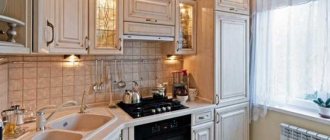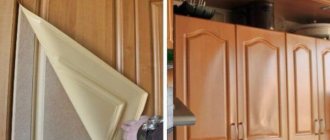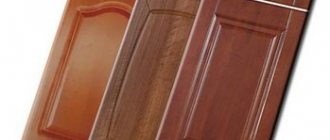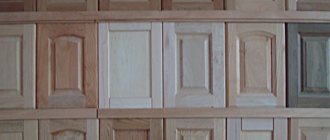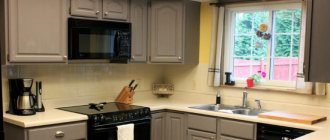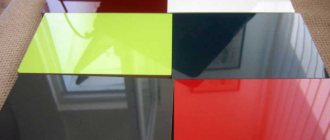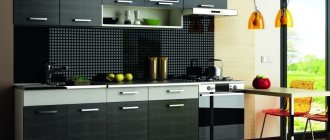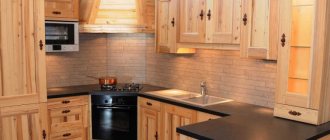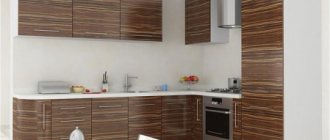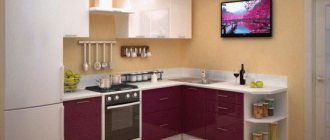Kitchen PVC facades - advantages and disadvantages
The kitchen facade in PVC film is a plate covered with a thin layer of polyvinyl chloride.
The advantages of film facades include:
- resistance to deformation and wear resistance;
- PVC is not afraid of moisture and moderate temperature influences;
- a wide selection of shades, coating textures and the ability to purchase a façade of any shape (curved, figured);
- lack of sensitivity to UV rays, due to which the panels do not fade or lose color;
- affordable price compared to veneered, wooden and plastic products.
Film kitchen facades also have disadvantages that you need to know about before purchasing. The first, and most unpleasant one, is that the PVC coating may peel off, especially if the cabinet is located above the hob. In addition, the film is susceptible to mechanical damage and can deteriorate when using cleaning agents with abrasive particles, and is also not subject to restoration (except for cases where it comes off).
What are the advantages and disadvantages of PVC coated MDF?
Compared to products made from chipboard, kitchens made from MDF are more expensive. However, if you consider the benefits that the owners will receive during long-term and flawless operation of a high-quality headset, all questions disappear by themselves. It’s better to pay a high price once than to completely change a kitchen that has lost its appearance every 3-4 years, or buy additional units to replace broken ones.
Experts note that, in terms of price/quality ratio, kitchens made from film MDF are an ideal option. They are more practical and durable than products made from chipboard and even natural wood. And their appearance is unrivaled!
What other advantages does this material have?
- Made using the technology, MDF boards with polyvinyl chloride coating are environmentally friendly and completely safe for the health of adults, children and pets. They do not emit formaldehyde, acetone and other toxic substances. Furniture made from such material does not have any unpleasant odor. If the film is not exposed to direct sunlight or constant high humidity, it is completely inert.
- The film is not afraid of exposure to ultraviolet rays. It does not swell with bubbles and does not peel off, even if the kitchen faces the south side and sunlight constantly falls on the set. Also, it does not lose color saturation.
- MDF plates with a protective film layer can be used as worktops and kitchen aprons. They are not at risk of short-term temperature rises up to 2700; there are no “scorched” marks left on them. The film reliably protects the surface from accidental damage from a knife, sharp cutlery, fallen solid objects, exposure to alkalis and acids. On such a countertop, you can safely pound meat, cut tomatoes or lemons, without fear for the integrity of the protective coating. Even accidentally spilled tea or coffee does not leave irreparable marks on it, unlike products made from natural wood or marble.
- Surfaces made from film MDF are extremely easy to maintain. They do not require specialized polishes or expensive compounds or special wipes. It is enough to walk with a damp, clean cloth a couple of times so that all dirt disappears without a trace from a smooth, durable surface. If you spill something particularly stubborn, like melted fat or food coloring, you can use a regular soap solution or an inexpensive household cleaner to remove the stain.
- Due to the special properties of MDF boards, elements of a wide variety of shapes and sizes are made from them. These can be intricately curved, curly, small and large details. Therefore, the design of kitchen sets is very diverse. Thoughtful design makes the kitchen more functional and convenient to use. And non-standard designs are relevant in the case of an unusual room layout: with bay windows and projections, niches and arches.
Of course, one cannot fail to note the rich selection of color palettes and textures. Buyers can easily choose a model that ideally matches the finishing of walls and floors, as well as existing furniture.
- Thus, dark glossy facades look very respectable and expensive. They visually expand the space of the room, making it deeper.
- Light shades effectively act on expansion, creating the impression of a spacious room, full of light and air, filling the atmosphere of the kitchen with a light, airy mood.
- Bright accents create a cheerful, festive mood for the whole day and help you look at life with optimism.
Surfaces that imitate natural wood and stone are perfect for classic interiors, rustic and eco-styles. The set looks solid and aristocratic. If you add the patina effect to this, you get the complete impression of an old mansion with expensive antique furniture. For such products, bronze, copper or gold fittings are appropriate. And the facades can be decorated with stained glass inserts.
Base for PVC film coating - materials and requirements
The PVC-coated panel consists of three parts:
- basics;
- films;
- edge finishing (sides).
Not every base is suitable for covering with film. Manufacturers use two options - chipboard and MDF.
Chipboard facades will be cheaper, but their durability is a very controversial issue. This material absorbs moisture well and swells, causing the film to begin to peel off. In addition, the toxic resins that make up chipboard can evaporate into the air when the integrity of the coating is damaged and have a toxic effect on the human body and domestic animals.
It is thanks to cheap chipboard structures that film coating has an undeserved reputation as a low-quality and unreliable material.
Theoretically, PVC can also be coated on panels made of well-sanded natural wood. But, as a rule, the manufacturer does not strive to hide, but rather to emphasize the appearance and natural pattern, so wood is also not suitable for applying film.
PVC coating is best used for facades made of MDF - an environmentally friendly and safe material with high performance characteristics. It does not deform, is resistant to moisture and high temperatures, and its smooth, jagged surface reduces the risk of film peeling.
Application technology
Polymer coatings are the main option for finishing furniture facades. Depending on the complexity of the surface being treated and the type of material, there are three options for applying decorative and protective coatings for furniture - lamination, lamination and post-formatting.
Laminating
The process of covering the base surface with facing materials in order to improve the aesthetic characteristics of the finished product is called laminating. The application technology is carried out at different temperatures using special equipment:
- cold lamination - cold processing of PVC film for furniture facades is suitable for smooth surfaces. The part is covered with glue and a film is rolled under pressure;
- warm lamination - before applying the decorative coating, the glue is heated to release excess moisture. The material is pressed to the surface until the glue polymerizes;
- hot lamination - the technology of film application is carried out at a temperature of 120-160°C using hot rollers of machine equipment.
During the production process, waste PVC furniture film is generated if the material is deformed under heavy load. There are restrictions on the use of lamination when processing chipboard and MDF - the surface must be smooth. The glue securely fixes the PVC and is evenly distributed over the base of the part due to temperature heating and the use of vacuum pressing equipment.
Lamination
When laminating, the product being processed is wrapped in film without applying glue. A durable protective coating is obtained under high temperature and pressure. Lamination technology makes it possible to process structurally complex elements and uneven surfaces. The features of the process are as follows:
- at high temperatures, furniture film becomes plastic;
- under pressure, the material is securely fixed to the base of the facade;
- the technology is suitable for processing elements made of MDF and chipboard;
- rolling film material onto radial facades;
- For crimping, films coated with synthetic resins are used.
The lamination process produces a solid web that is not prone to delamination. Finished products do not allow moisture to pass through and are chemically stable. If a manufacturing defect occurs during the production process, waste PVC furniture film can be used for recycling.
Post-formation
Postforming is considered the most effective way to process MDF facades in furniture production. The essence of the process is to apply a layered coating to the base. The material must withstand the dynamic load of the pressing equipment. Main differences of the technology:
- for post-formation, flat polyvinyl chloride is used;
- process straight, curved, curved, radial facades;
- the coating is applied to the glue, mainly on positioning machines;
- the material is pressed with a press with a relief surface;
- An imprint remains on the façade, giving the product an original texture.
Postforming technology makes it possible to process complex parts coated with a film material of high strength and moisture resistance.
Using various techniques for applying PVC to furniture facades, products can be given an original design. The material is presented in a wide range - there are options in subdued colors that strictly imitate natural materials, and films of bright and variegated colors for complex design compositions.
Types of PVC films for kitchen facades
To cover the facades, PVC film with a thickness of 0.05 to 0.8 mm is used. Depending on the application method and performance properties, the following types of material are distinguished:
- membrane-vacuum film (0.25-0.5 mm) - intended for vacuum pressing of bent facades;
- PVC for laminating (up to 0.3 mm) - used for laminating smooth panels;
- PVC for lamination (0.3-0.5 mm) - allows you to laminate surfaces not only in one, but also in several layers.
For home use, self-adhesive film in rolls (0.3-0.5 mm) is used.
PVC coating is applied in one of three ways:
- laminating;
- lamination;
- post-formation.
Laminating is based on preliminary application of glue to the base and pressing the film against it under conditions of high pressure and temperature. The cost of lamination for the manufacturer is much more economical, but the quality of gluing leaves much to be desired - PVC can quickly peel off.
Lamination is the cladding of a façade at critical temperatures. After applying the film, the facade is additionally covered with a protective layer. This method is much more reliable than laminating.
Postforming is the most advanced technology for applying PVC. The film is applied to the surface in an even layer and then placed under a special press. If it is necessary to give the cladding a certain pattern or shape, then it is also adjusted under the press.
<
>
Self-adhesive film can be used to cover furniture at home. First, you need to thoroughly clean the surface of the facade from dust and wipe it with a degreaser (for example, white spirit), and then carefully apply the PVC coating. To get rid of bubbles, the coating can be smoothed with a spatula wrapped in cloth. Unfortunately, such film will not last long.
When choosing a film, pay attention to the country of origin. It is believed that products from European manufacturers are more reliable, PVC from Italy is especially valued. However, factory-made Chinese and Korean film is no worse, but costs less.
Methods of application
Polymer materials are a very popular finishing option; they provide neat facade decor and protection from many external factors. According to the method of application, PVC coatings are divided into the following types:
- Membrane-vacuum. The equipment used is a vacuum press, most often used for countertops, doors between rooms, cabinets, chests of drawers, bookshelves. Thickness - from a quarter to half a millimeter.
- Laminating. The process of gluing or pressing together two surfaces is called laminating. It is carried out using special equipment. It is used for various surfaces made of fiberboard and MDF, including window sills. The thickness of the cladding usually does not exceed three tenths of a millimeter.
- For lamination. Cladding is done on a machine because work is usually carried out on fairly long elements made of metal, plastic or wood in order to protect them from water and give them strength. Two-layer PVC film provides more complete protection from influences, including sun rays.
- Transparent. This type of material is very thin, almost like food grade, it does not perform its functions for too long, but it stretches well, and it is convenient to completely cover the product. Usually it is chosen for transporting something, securing it to the surface of the cargo with glue that does not leave any traces behind.
- For chipboard and MDF. Intended for individual parts, for example, ends. A special machine is used to stretch it, so it is difficult for a beginner to achieve good quality at home, although some craftsmen try to do this, using, for example, a hair dryer.
Assortment of furniture lamps, examples of design and placement
Film can be applied to surfaces in different ways:
- Laminating. This process has several subspecies, differing in temperature. Smooth elements are processed using the cold method, glue is applied to them, and then the coating is rolled under pressure. During warm processing, the glue is preheated to melt off excess water. The hot type of finishing is carried out at a temperature of 120-160 degrees, using heated rolling rollers.
- Lamination. In this case, no glue is used; the fastening effect is exerted by heat and pressure, which make the substance plastic. The result is a solid, non-delaminating fabric. Waste material is subject to recycling and reuse.
- Post-formation. The most effective option. The layered coating is applied to a base coated with glue on a positioning machine. The press used has a relief that gives the finished product an interesting texture.
Glossy PVC film is usually applied using a vacuum method.
Every technology has its limitations. For example, when laminating, it is imperative that the object be smooth, without protruding fragments or nicks. During post-formation, it must withstand the load that the equipment will place on it.
Updating the interior with recessed furniture lamps
In general, polyvinyl chloride film for furniture facades is easy to use and has many advantages. It not only gives the furniture a glossy and presentable appearance, but also saves it from accidental damage and premature aging, chemical, thermal and other influences.
For chipboard and MDF
Membrane-vacuum
Transparent
Decorative qualities of PVC film facades for kitchen units
Kitchen PVC facades can have a variety of colors and textures. Film manufacturers take into account fashion trends: as soon as a certain material becomes popular, they produce a PVC coating that imitates its shade and texture. Thanks to this technique, you can purchase facades “metal-like,” “wood-like,” or “glass-like.”
The film can be:
- glossy;
- matte;
- mirror
Thanks to modern technologies, various images and patterns can be applied to PVC coatings. 3D drawings that imitate three-dimensional details - stucco molding, milling or decorative carvings - have become widely popular.
Rules for care and operation - how to extend the service life of a kitchen facade with PVC film coating
The quality of care for PVC facades has a serious impact on their durability and appearance.
To make your furniture pleasing to the eye longer, follow these recommendations:
- do not use abrasive and chemically aggressive chlorine-based detergents to clean the panels;
- protect facades from mechanical damage - scratches and impacts;
- do not expose surfaces to temperatures above 70. If a cabinet with a PVC facade is located above the hob, it is advisable to use a powerful hood;
- Film overcooling is not allowed - up to - 15.
But what to do if the PVC film peels off? In this case, you must first check whether the warranty period for the furniture has expired. If not, the manufacturer will restore the furniture himself, but only if you followed the recommendations for caring for the furniture.
If the warranty period has expired or the coating has peeled off due to careless handling of the facades, you can restore the film yourself.
To do this you will need glue or liquid nails. You can also use PVA; PVA Moment Joiner is especially suitable. It needs to be drawn into a medical syringe (you can use a special glue gun) and carefully inserted under the peeled off section of the film. Then press firmly and remove the remaining substance with a cloth.
Pros and cons of using
PVC film for furniture facades has a number of significant advantages:
- combination of strength with high elasticity, which prevents tearing of the material during use;
- water resistance;
- low thermal conductivity;
- resistance to many chemicals, deformation, heat and cold;
- there is no fading because the material is impervious to ultraviolet radiation, that is, even when exposed to direct sunlight it will not fade;
- favorable cost, especially in comparison with simulated materials - stone, wood, marble;
- high-quality drawings, interesting textures, impressive appearance of films.
Due to its resistance to moisture and heat, PVC can even be used in the interior of a kitchen or bathroom, where other materials would quickly begin to deteriorate.
However, one cannot fail to note the possible disadvantages:
- self-adhesive PVC film may begin to peel off or bubble if it cannot withstand constant changes in temperature, humidity, and direct rays of the sun;
- sometimes it breaks or is accidentally cut with a knife, then the coating cannot be restored or a separate fragment can be replaced without losing aesthetic qualities, everything has to be re-glued.
Types and features of furniture varnishes, their characteristics
In order not to spoil the self-adhesive PVC film, it is better not to clean it with abrasive materials (a sponge with soapy water is perfect), not to cut anything on it with sharp objects, not to expose it to too much heat or cold, or sudden changes temperature. Despite the fact that it must withstand this, its service life will increase significantly if these simple rules are followed.
Photos of kitchens with PVC film facades
<
>
Thus, PVC-coated facades are an inexpensive, stylish and practical option for decorating kitchen furniture. A wide selection of shades and textures will help you decorate your kitchen in any style. And if the operating rules are followed, panels covered with film will last a very long time.
